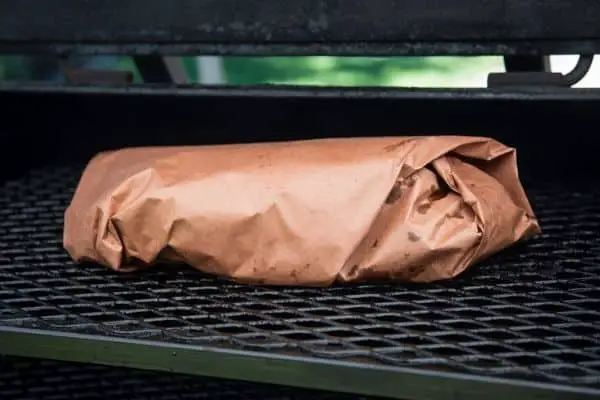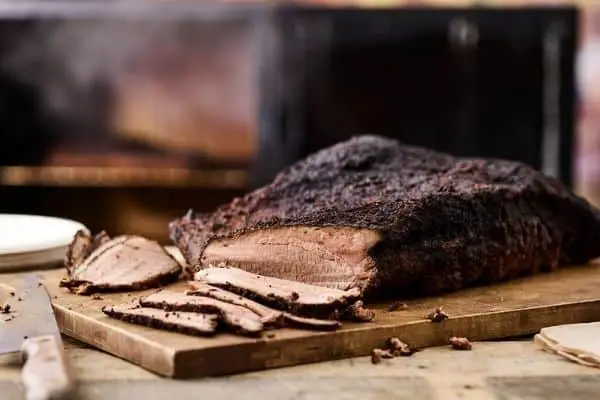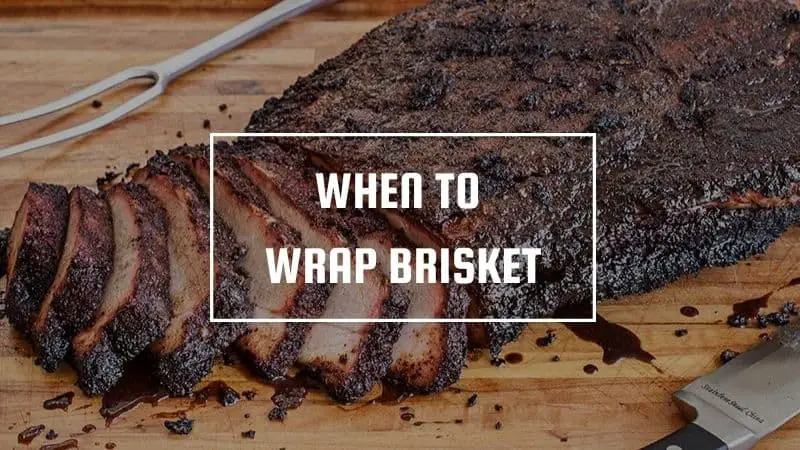There are many different opinions on when to wrap brisket, but the general consensus is that you should wrap it before it reaches 165-170 degrees Fahrenheit. This will help keep the juices inside and ensure that your brisket tastes tender rather than dry or tough.
No matter what method you use (smoking, grilling, roasting), slow cooking your brisket for 10 hours at 225 degrees will give you a perfect roast with amazing flavor. When wrapping our meat in foil we always try to leave an opening so that air can circulate around the edges of the roast as well as over top for crispy skin.
It’s important not to let too much heat escape from your smoker or oven because this could affect the cooking time of your brisket. If you wrap it too early, some may argue that this reduces bark formation and leads to more tender meat but who wants tough brisket?
When to Wrap Brisket?
The majority of barbecue gurus recommend wrapping the brisket after it achieves temps of 165 to 170 degrees Fahrenheit.
Benefits of Wrapping Brisket
Cooking time is reduced
Large cuts of meat will be subject to your stall’s requirements. The meat you are cutting may be maturing well and on schedule to be served at the desired time. When the internal temperature of the meat gets around 165 degrees Fahrenheit, it seems to stop cooking.

What is occurring? This is also what keeps you cool on a hot summer day. Evaporation. In essence, once the flesh begins to sweat, the water may rise to the top and begin to evaporate. It serves to chill the whole item. The conflict between evaporation and smoking reaches a stalemate, and the standstill begins. It may take up to six hours.
By wrapping briskets, you eliminate the air that evaporates moisture. A coating of the brisket’s juices coats its surface, and the fluids stay hot owing to the smoker’s hot air circulation. The less air that flows around the meat’s exterior, the hotter it gets.
Because the wrap shields the brisket from direct heat produced by the smoke, you may increase the temperature of your smoker without fear of scorching or drying out the outside of the brisket.
After evaporation is decreased, the smoker’s heat output rises in the race to the stall. As the meat cooks, the temperature begins to rise — which is desirable since brisket gets more tender as it is smoked.
Protect The Brisket
While the brisket is cooking in the smoker, the rub will develop a nice crust and become a lovely reddish/mahogany color. If the brisket is not covered, the color may darken and may end up appearing like a meteorite.
While cooking Briskets, I’ve discovered that the rub usually sets and I can get the proper color as soon as the meat reaches temps of 150F. Generally, it requires between 5 and 6 minutes for smoke at 250F to reach the desired temperature. Your mileage may vary based on the size and weight of your brisket, as well as the temperature of your smoking equipment.
Along with concealing the color of the brisket, wrapping aids with taste preservation. One of the most common mistakes chefs make when cooking briskets is using too much smoke, which results in a bitter brisket with a little creosote flavor. When the brisket reaches 150F, wrap it in foil to prevent it from absorbing any more smoke flavor.
Juicer Meat
Wrapping brisket in a wrap seals in the meat’s delicate and delectable natural juices. Once your brisket has been smoked, wrap it and begin cooking it.
Some think that this will result in a stronger smoke taste, however, the flesh absorbs all smoke until the moment of stalling.
Wrapping meat in a wrap is a popular technique for retaining taste and moisture, especially in tropical areas where leaves are used. The same concept applies to beef wrapping.
Disadvantages of Wrapping Brisket
The primary downside of wraps is that a wrapped brisket may taste somewhat less smoky than an open brisket. Other disadvantages include the bark losing its texture as well as the danger of overcooking.
Slightly Reduced Smoke Flavor
Wrapping the brisket creates an air barrier between the smoke from the wood and the meat. As a result, the meat receives less smoke taste.

It’s not a big issue since you’ll already be smoking the meat for many hours prior to wrapping it. The bulk of the flavor of the smoke is absorbed into the meat during the first few minutes of cooking.
The benefits of wrapping — faster cooking, better control over the bark, and more tender meat — outweigh the little loss of smoke taste.
Potential Of Overcooking
After wrapping the brisket, its internal temperature could start rising. The temperature increase is very unexpected and will vary depending on a variety of variables like as the tightness of the wrap and the humidity level in your smokers.
This is a frequent omission when using a probe thermometer rather than following the instructions. It is much more efficient to cook according to temperature than than time, since timing is irrelevant when dealing with mushy briskets.
Every 30 to 60 minutes, measure the temperature of the brisket using a meat thermometer. Simply pierce the wrapper until the meat reaches 203 degrees Fahrenheit. This is not a concern since the hole will not obstruct the cooking process or result in water loss.
Texture Loss In Bark
A brisket’s tight wrapping will keep it moist. This will assist in expediting the cooking process. However, it will soften the thick bark that covers the brisket’s surface, more malleable.
After the meat reaches the desired temperature (most experts recommend 203°F), remove the wrap and roast it to approximately 225°F for a second time to crisp the bark.
Bear in mind that the brisket will become very hot once removed from the wrapper, which is normal. As long as the temperature inside reaches 203 degrees, it will remain sensitive.
How to Wrap the Brisket
Wrapping Brisket in Aluminum Foil
Wrapping the brisket with aluminum foil is the simplest method, since it requires little expertise to do so well.
It’s the ideal option for novices or those making their first attempt. It’s also the most practical choice since many individuals already have aluminum foil on hand.
The cooking time will be about 11 hours. The bark is tender and meaty, with a wonderful beef taste.
Here’s a step-by-step guide to wrapping it:
- Aluminum foil is the most often used substitute for Texas Crutch. It is the first Crutch in Texas and is perfect for people with little expertise! The first step is to verify that aluminum foil is available!
- Cut the aluminum foil in half and then into two arm-length pieces. Place one aluminum foil sheet on top of the other and the brisket in the center of both. It is critical to construct the second layer to ensure the brisket is wrapped correctly.
- Wrap the aluminum foil fully around the Brisket. The more firmly you wrap the meat, the quicker it cooks!
- Because brisket cooked in a wrap cooks more quickly, it’s critical to monitor the temperature of the beef closely to avoid overcooking or burning the meal. It is recommended that you take temperature readings at least once every 30 minutes.
- Continue to check the meat’s temperature until it reaches 203°F. This indicates that the brisket has been cooked and is now ready to eat!
Wrapping Brisket in Butcher Paper
The next step is to consider wrapping in butcher’s paper. Wrapping the meat in butcher’s papers allows some of the package’s steam to escape. It helps maintain the bark, which is why we like to wrap the brisket in butcher’s papers.
Here’s a step-by-step guide to wrapping it:
- Assemble a big sheet of paper. It’s usually prudent to get a larger sheet size. However, the bulk of the time, smaller sheets are utilized since they are the more often used.
- Remove the brisket from the grill and place it on the paper roll’s bottom. Wrap the opposite end of the paper with the partly wrapped brisket into a triangle shape. Then, fold the wrap’s opposite end around the meat. This manner, you’ll be able to construct a seal that will keep the juices contained inside the meat throughout the smoking process.
- You’ll need to do something somewhat different here, since butcher’s paper is often smaller than the size specified. By utilizing an extra piece of parchment, flip the brisket over and make it on the other side.
- Wrap it around a pizza cutter to create a pizza shape. You may next add a layer of butcher’s sheets if desired, although it is not necessary.
- It should be folded in half and reinserted into the smoker.
FAQs
1. What temp to wrap brisket?
When the internal temperature of the brisket reaches 150degF, it should be wrapped (65.5degC). Brisket usually enters the stall at a temperature of about 150degF, which means that the temperature within the meat will only slightly rise. Wrapping the beef in foil extends the cooking time and allows the brisket to pass through the stall and then rise to a temperature of 203deg-203degF.
2. Is it better to leave the brisket wrapped or unwrapped?
Always keep the brisket wrapped in its original wrapping. Because the meat will continue to cook throughout the carryover phase, it is critical to wrap it at this time. Wrapping will keep the fluids contained and prevent you from losing the delectable sauce.
During the resting period, the brisket will absorb a significant amount of its fluids. The easiest way to rest the brisket is to cover it in foil, then wrap it in oiled cloth and store it in an airtight cooler. Rest the meat for at least a couple of hours. Even after four hours of rest, it’s still heated.
3. Foil vs Butcher Paper
While foil wrap is a well-known technique of wrapping brisket, butcher paper has gained favor in recent years as a result of Aaron Franklin’s brisket expertise. Butcher paper is a special kind of paper that works very well with brisket. What you use to wrap your brisket is entirely up to personal taste, but the only way to discover what you like is to experiment. There will be some variation in the texture of the bark, but there is no definite way to decide which option is the best.
Conclusion
If you’re looking for some delicious brisket, be sure to know when to wrap it. Be aware of the risks and benefits associated with wrapping your meat in aluminum foil or not. Wrap at the right time and temperature, if you choose doing so at all. Remember that marinating is a great way of keeping your dish moist while also adding flavor! We hope this article has helped answer any questions about whether or not wrapping brisket is worth it. Now go get cooking!
